Media converters is usually involved in all types of networks to implement and optimize fiber links. For example, it can be deployed in local area network (LAN) to integrate fiber optic cabling and active equipment into existing copper-based, structured cabling systems while achieving significant cost-savings. Moreover, media converter also plays a significant role in today’s multi-protocol, mixed media network. It has become a flexible and cost-effective networking devices. This article will mainly explain the benefits concerning media converter, as well as its common types and applications.
What Is a Fiber Media Converter
Currently, the most used media converter is a device that functions as transceiver, converting the electrical signal used in copper unshielded twisted pair (UTP) network cabling into light waves used in fiber optic cabling. Media converter is rather essential when fiber optic connectivity is required. This happens when the distance between two network devices exceeds the transmission distance of copper cabling. Media converters enables two network devices with copper ports to be connected over extended distances via fiber optic cabling.
In addition to copper-to-fiber conversion, media converters also provide fiber-to-fiber conversion from multimode fiber to single-mode fiber, and convert a dual fiber link to single fiber using bi-directional (BIDI) data flow. Media converters can also convert between wavelengths for wavelength division multiplexing (WDM) applications.
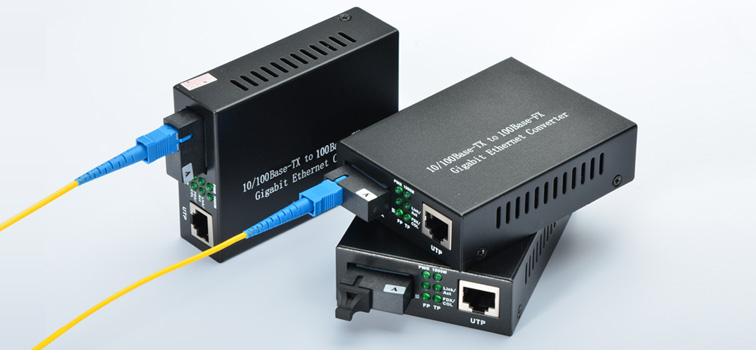
Benefits of Media Conversion Technology
The ever-increasing demand for higher bandwidth and longer distance transmission has made media converter even more important. By allowing the use of fiber when it is needed, and integrating new equipment into existing cabling infrastructure. Media converters provide seamless integration of copper and fiber, and different fiber types in enterprise LAN networks. They support a wide variety of protocols, data rates and media types to create a more reliable and cost-effective network.
Media converter helps to increase network distances by converting UTP to fiber thus to extend fiber links for longer distance data transmission. Which may contribute a lot to maintain investments in existing equipment. Moreover, media converter can also increase the capacity of existing fiber with WDM wavelength when used with multiplexers.
Types of Media Converters
There are a wide range of copper-to-fiber and fiber-to-fiber media converters available that support different network protocols, data rates, cabling and connector types. In this part, we will mainly introduce some of the most commonly used media converters.
Ethernet Copper-to-Fiber Media Converters
Supporting the IEEE 802.3 standard, Ethernet copper-to-fiber media converters provide connectivity for Ethernet, Fast Ethernet, Gigabit and 10 Gigabit Ethernet devices. Some converters support 10/100 or 10/100/1000 rate switching, enabling the integration of equipment of different data rates and interface types into one seamless network.
Point-to-Point Applications
A pair of media converters can be used in point-to-point connections that connect two UTP Ethernet switches (or routers, servers, hubs, etc.) via fiber, or to connect UTP devices to workstations and file servers.
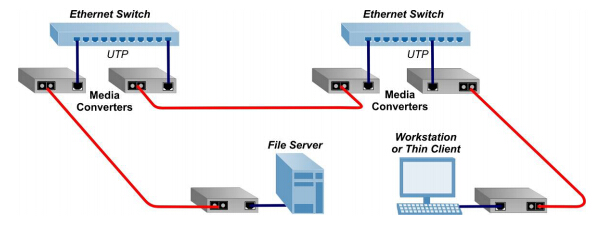
Campus Fiber Application
In this application example, 10/100 media converters are installed in a redundant power chassis for high-density fiber distribution from UTP switch equipment (A) at the network core. A UTP workgroup switch (B) is connected via fiber to the network core with a standalone 10/100 media converter. Another 10/100 converter enables fiber connectivity to a PC UTP port in a fiber-to-desktop application (C). An Ethernet switch (D) is connected directly via fiber to the media converter module at the network core.
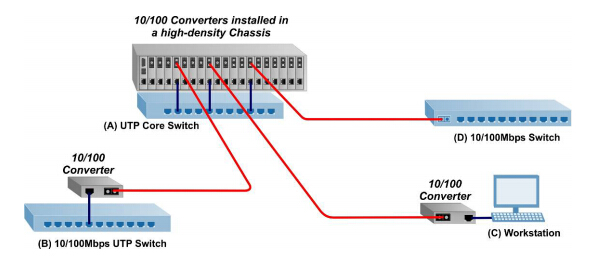
Serial-to-Fiber Media Converters
Serial-to-fiber converters provide fiber extension for serial protocol copper connections. They can automatically detect the signal baud rate of the connected full-duplex serial device, and support point-to-point and multi-point configurations.
RS-232 Application
RS-232 fiber converters can operate as asynchronous devices, support speeds up to 921,600 baud, and support a wide variety of hardware flow control signals to enable seamless connectivity with most serial devices. In this example, a pair of RS-232 converters provides the serial connection between a PC and terminal server allowing access to multiple data devices via fiber.
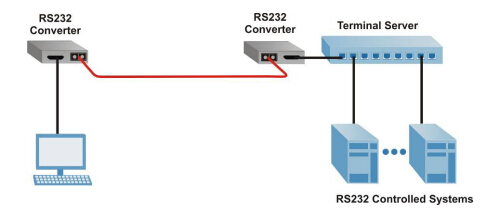
RS-485 Application
In this application, a pair of RS-485 converters provides the multi-drop connection between the host equipment and the connected multi-drop devices via fiber.

Fiber-to-Fiber Media Converters
Fiber-to-fiber media converters can provide connectivity between multimode (MM) and single-mode (SM) fiber, between different “power” fiber sources and between dual fiber and single-fiber. In addition, they support conversion from one wavelength to another. Fiber-to-fiber media converters are normally protocol independent and available for Ethernet, and TDM applications.
Multimode to Single-mode Fiber Conversion
Enterprise networks often require conversion from MM to SM fiber, which supports longer distances than MM fiber. Mode conversion is typically required when:
- Lower cost legacy equipment uses MM ports, and connectivity is required to SM equipment,
- A building has MM equipment, while the connection to the service provider is SM,
- MM equipment is in a campus building and SM fiber is used between buildings.
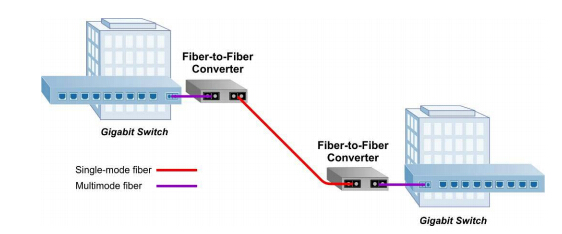
Dual Fiber to Single-Fiber Conversion
Enterprise networks may also require conversion between dual and single-fiber, depending on the type of equipment and the fiber installed in the facility. Single-fiber is single-mode and operates with bi-directional wavelengths, often referred to as BIDI. Typically BIDI single-fiber uses 1310nm and 1550nm wavelengths over the same fiber strand in opposite directions. The development of bi-directional wavelengths over the same fiber strand was the precursor to wavelength division multiplexing.
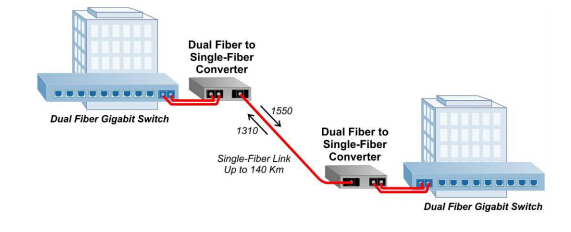
Conclusion
Simple and robust in design yet cost-effective to deploy, media converters are the best solution for the rapidly growing demand of new networking applications. Besides, they bridge the existing bandwidth gap between the LAN and service provider fiber optic backbone.

No comments:
Post a Comment